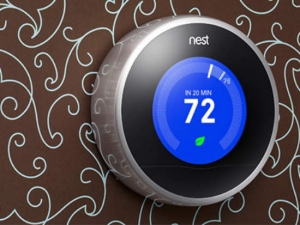
By opening its checkbook, Google has quickly reversed many peoples’ dim view of clean tech.
Google on Monday announced it will acquire Nest Labs for an eye-popping $3.2 billion dollars. Founded by former Apple engineers Tony Faddell and Matt Rogers (appearing in the video below), the four-year-old company makes a popular smart thermostat and combination smoke and carbon monoxide detector.
With its successful products and ample funding from venture investors, Nest was already considered a successful startup. But Google’s acquisition cements the idea that innovative companies can make desirable products that improve energy efficiency, long a staple of the clean tech investment category.
Before Nest’s thermostat, energy efficiency garnered little buzz in the media and scant attention from high-profile venture capitalists. The product has gotten rave reviews because it combines energy saving with other conveniences, such as remote access via a smart phone app, and the product's Apple-like industrial design.
What was once a boring and seldom-used product — the programmable thermostat — became desirable. Along the way, Nest has been able to save a great deal of energy by reducing waste.
"Starting a business focused on the lowly thermostat seemed like a crazy idea at the time, but it made all the sense in the world to us," said Faddell in a company blog announcing the deal. "That little device that went unnoticed and unchanged year after year on the walls of our homes was a lost opportunity to save energy and money. We knew we could do better."
Depending on your point of view, Nest can be seen as an example of an innovative Internet of Things company or part of the trend towards hardware startups. But people who work in clean tech yesterday were quick to point out how Google’s acquisition of Nest validates the notion that there’s money to be made in resource-saving technologies. The deal comes a week after 60 Minutes aired a show on the “Clean Tech Crash” that focused on the difficulties of biofuels and battery companies in delivering good returns to investors and government-funded programs.
As a business, Nest is the polar opposite of the energy companies that characterized the first wave of clean-tech startups, which required large sums of money, many years to commercialize, and often scientific breakthroughs. At heart a consumer electronics company, Nest's first two products focus on creating an excellent user experience with a combination of technologies, including cloud-based services, machine learning, and hardware design.
“The next wave of clean tech venture capital looks a lot more like Nest than it looks like (failed solar company) Solyndra et al. Downstream reinvention FTW,” wrote investor Rob Day on Twitter on Monday.
The deal has implications for the electric power industry because the thermostat can be a gateway to deliver energy-related services. Nest has a product called Nest Energy Services, through which utilities offer demand response services. During hours of heavy usage, such as very hot summer days when air conditioning loads peak, utilities call on demand response participants to raise their thermostats to reduce power use.
 Anyone
remember Google PowerMeter?Traditionally, utilities
have run demand response programs with air conditioner controllers,
which didn’t give consumer control over how and when they
participate in demand response. Nest’s thermostat and accompanying
app give consumers more flexibility and can, for example, use
cloud-based analytics to precool homes and minimize discomfort. With
more user-friendly products to work with, utilities could have more
success getting consumers to sign up for demand response programs.
Anyone
remember Google PowerMeter?Traditionally, utilities
have run demand response programs with air conditioner controllers,
which didn’t give consumer control over how and when they
participate in demand response. Nest’s thermostat and accompanying
app give consumers more flexibility and can, for example, use
cloud-based analytics to precool homes and minimize discomfort. With
more user-friendly products to work with, utilities could have more
success getting consumers to sign up for demand response programs.
Google in 2011 decided to discontinue a Web-based energy monitoring product called PowerMeter during a restructuring. With Nest, Google could potentially broker demand response services or analyze home data usage to offer recommendations to improve home efficiency. In a blog, Nest co-founder and vice president of engineering Matt Rogers said there will likely be many ways in which Google's services will work with Nest's products.(He also said Nest's privacy policy of only using customer data to improve products will not change.)
Having assembled a team of over 300 people with skills in everything from robotics to user interface design, it’s widely believed Nest will eventually have a full line of home products that are connected and use digital technologies to improve the user experience. “We loved the unloved,” Rogers told Joel Makower in October. “The more unloved, the more unsexy, the more white plastic kind of stuff that’s out there is ripe for us. We love to disrupt huge markets.”
Regardless of where Nest goes next, it’s already shown that saving energy doesn’t require sacrifices. Done right, efficiency is just part of a well-designed modern products do.